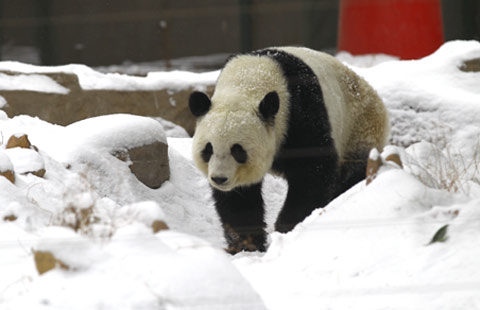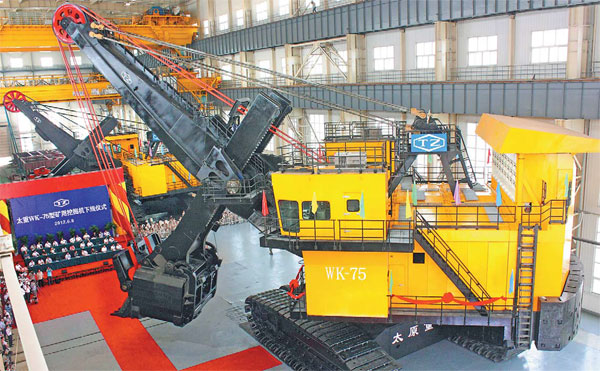Taizhong does heavy lifting
Updated: 2014-02-28 08:44
By Li Yang (China Daily Europe)
|
|||||||||||
|
Taiyuan Heavy Industry Co Ltd is China's largest producer of hoisting and excavating equipment, space launch gear and heavy milling machines. Provided to China Daily |
A machinery maker that is almost as old as the People's Republic continues to be a trail blazer for the nation's manufacturers
It began life in 1950 as the first producer of heavy equipment in the infancy of the People's Republic of China. Retired workers proudly call it "the oldest son of the republic", which itself came into being just a year earlier.
Taiyuan Heavy Industry Co Ltd (Taizhong) is now China's largest producer of hoisting and excavating equipment, space launch devices and heavy milling machines, among other products.
Known as a "trailblazer" for the nation's economy, Taizhong made many of the first pieces of heavy equipment for a country emerging from decades of devastating conflict.
In its first decade, it drew on the help of engineers from the former Soviet Union.
During those years, Taizhong made China's first large bridge crane (1955), its first sheet rolling mill (1959) and its first 4-cubic-meter power shovel, first portal crane (a type of machinery often used in shipyards) and first train wheel rolling mill (1961).
This much-needed machinery saved China large amounts of foreign currency at a time when the nation had little.
These products also helped in the construction of key heavy industrial and infrastructure projects in the 1950s and 1960s.
Taizhong's operations were paralyzed by the "cultural revolution" (1966-76), and the company did not resume full production until the early 1980s.
As China opened up to the West, Taizhong quickly found partners in Europe, the United States and Japan.
It made the first large crawler crane in China in collaboration with Demag Inc, from what was then West Germany, in 1982. That was the start of Taizhong's most productive period.
Throughout the 1980s, working with foreign partners, Taizhong made dozens of first-of-a-kind heavy machines in China.
"We were amazed by the level of technology and management of foreign companies. It was like two industrial eras meeting one another," says Zhang Zhide, Taizhong's chief executive officer and head engineer.
"We were all learning machines and made full use of every minute to make up the time lost in political movements. Yet, we always knew that one day, we would have to make machines of our own design."
Taizhong's international cooperation was at a low ebb in the 1990s. Its engineers used that time to digest and absorb the technology acquired in the 1980s.
By the late 1990s, Taizhong was able to make most of the heavy equipment China needed, and it even started exporting to some developing countries.
To raise its international market share, it started inviting experts from German, Austrian and Japanese companies to improve its technological standards.
Taizhong became the first listed machinery company in China in 1998.
At the turn of the millenium, the company began exporting forging and rolling mills, cast and forged pieces, cranes and mining equipment to about 50 countries.
Taizhong made the largest puncher in 1999, the largest bridge crane in 2000, the largest ladle crane in 2005 and the largest bucket mining excavator in 2008.
Sales increased by 33 percent on average annually from 2001 to 2008, when they reached 10 billion yuan ($1.6 billion; 1.2 billion euros).
By next year, the group aims to generate sales of more than 30 billion yuan, with exports accounting for more than 30 percent.
According to Wang Weiguo, director of sales, Taizhong's export revenue hit a record high of 1.6 billion yuan in 2008, although it declined to just 300 million yuan in 2009 as the global downturn hit.
"Export revenue recovered later and remained at about 1 to 1.3 billion yuan from 2010 to 2013," Wang says.
"Times have changed. Heavy equipment isn't as important as before in the US. And rising heavy equipment suppliers like Taizhong in emerging economies are taking developing countries' markets away from European companies, another result of the 2008 global crisis," Wang says.
After 2008, the Chinese central government's stimulus package not only boosted economic growth, but also led to severe overcapacity among heavy equipment producers.
Fierce price competition to sell large excavators, cranes and forging mills turned the business into a losing game for all.
"Without mentioning names, but there's a company in Northeast China. To win the bidding to supply a portal crane in Shanghai, the company offered a price only two-thirds of ours," says an engineer at Taizhong, who did not want to be named.
"Our price is already so low that we can't even figure out how to make money on the deal."
With competition getting so intense in the industry, Taizhong turned to new products. It invested 2 billion yuan to establish a Tianjin branch in 2011, which produces wind power and nuclear power equipment.
The branch also began making coal chemical equipment for foreign markets starting in 2012.
Also in 2011, Taizhong bought an Australian coal bed gas mining equipment producer, Valley Longwall International Pty Ltd. Taizhong says the acquisition will build up its competitiveness in China's coal bed methane sector and allow it to enter Australia's coal cutter market.
In terms of corporate structure, Taizhong, with 14.6 billion yuan in total assets and 14,000 employees, has its heavy machinery companies in Taiyuan and Tianjin, coal-mining equipment companies in Taiyuan and Australia, and a rail-related equipment enterprise in Taiyuan. It also has a hydraulic equipment company in Yuci, Shanxi.
According to the company, its most competitive products include wind power and nuclear power equipment, coal-mining and chemical industry equipment and high-speed train wheels, axles and wheel sets.
Taizhong, the only high-speed train wheel set producer in China, built a railway equipment industrial park in 2010 to expand production to meet rising export demand.
The 60-hectare park will ultimately have three separate workshops making wheels, axles and wheel sets.
"World market demand for wheels was very strong in 2010. We acted a little late. If we had built the park two years earlier, the returns would be much higher," Wang says.
"It wasn't an easy decision at that time, since it involved such a huge investment, given our limited net profit."
Costing 1 billion yuan, the wheel production line was the first to be complted. It began producing wheels for export in 2012.
The other two lines are still undergoing trial operations, with full operations expected to start this year, after gaining the approval of regulators.
To make steel ingots into wheels, the production line carries out several procedures: cutting, forging, heat treatment, machining and inspection.
The high-speed circular cutting saw is from Austria, and all the other equipment is imported from Germany.
With an annual designed production capacity of 300,000 units, the production line is said to be the most advanced in China.
Nick Teunissen, a sales manager for Global Railway Engineering Ltd from South Africa, has been to Taizhong to inspect the quality of the wheel sets. "There's no problem with their products," he says.
Even before the new park began operations, Taizhong had several old production lines making normal wheels, axles and wheel sets.
From 2008 to 2013, it exported 220,000 wheels and 100,000 axles for subways, freight trains, mining cars and high-speed trains.
Since 2010, Taizhong has exported 30,000 wheel sets. It is the only Chinese exporter of the product, says Jiao Peng, international trade department head of the company's rail transit equipment business.
"The profit margin for normal wheels and axles is narrowing fast. The new workshop for high-speed train equipment opened up bigger new markets for us," says Ren Xueyi, head of the new railway industry park.
China's high-speed railway network only came into existence in 2004. By last year, it had 100,000 kilometers of track, much more than was forecast in 2004. Analysts forecast the size will double in just a few years.
Taizhong obtained quality certificates from European authorities in 2012 and became the first Chinese exporter of high-speed train wheels, axle and wheel sets to Europe.
But Ren says that entering the global wheel industry "showed us how far our equipment manufacturing industry lags behind foreign companies. The gap is all-encompassing, from concept to material."
Sun Ruisheng contributed to this story.
liyang@chinadaily.com.cn
(China Daily European Weekly 02/28/2014 page22)
Today's Top News
Ukraine mobilizes after Putin's move
War in Ukraine a long shot, experts say
Beijing-area air better than before
EU condemns China's terrorist attacks
Abe 'shut the door': spokesman
Putin not yet decided on use of force in Ukraine
28 dead in Kunming violence
China, UK hold dialogue on ties
Hot Topics
Lunar probe , China growth forecasts, Emission rules get tougher, China seen through 'colored lens', International board,
Editor's Picks

|

|

|

|

|

|






